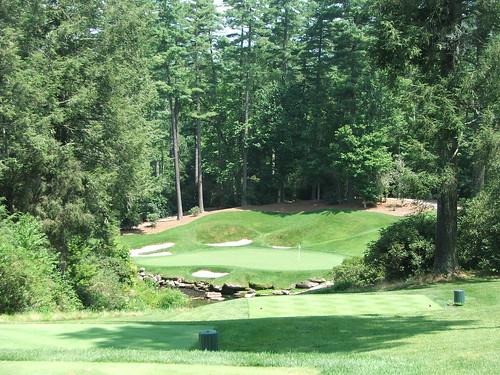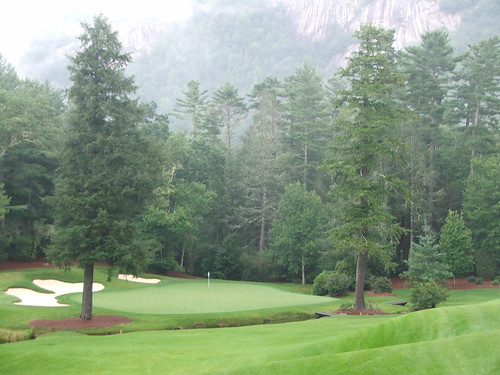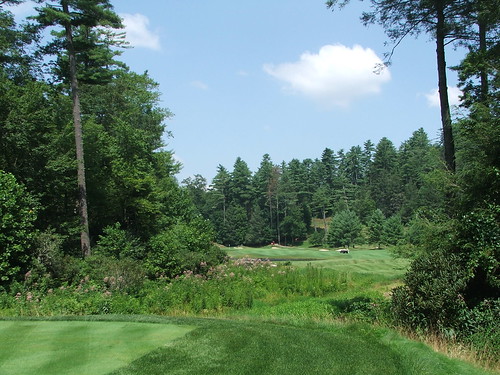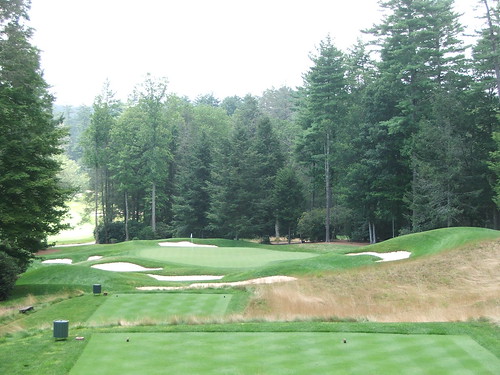 Wade Hampton sporting a serious handlebar mustache
Wade Hampton sporting a serious handlebar mustacheThe course was designed by Tom Fazio, and he remains an active member today. The club was opened in 1987 with 120 charter and founding members, all from below the Mason-Dixon Line: seven from Augusta, Georgia and the remainder from Florida, Alabama and North Carolina. Although the membership has changed somewhat since the club's founding, Wade Hampton remains a below-the-radar Southern club. Similar to Fishers Island, in order to be a member of the club, you have to own property or a house bordering the course, making it a small, tight knit group, which explains why it took so many years for this cantankerous Yankee to get invited to play.
At the guard-gated entrance we were greeted with a big "Good maw-nin." Once through the gate you make a "ryat" followed by a "layft" to get to the clubhouse.
The course has a program where they sponsor young adults from South Africa to apprentice as caddies and in other jobs to learn the golf business. These well-mannered youngsters add some nice character to Wade Hampton. The course also has the nicest staff of any course I have visited. As at the Honors Course and Muirfield Village, your car is valet parked. EVERY employee greeted us warmly and welcomed us to the club. This was consistent all day long; they have really developed a culture of service excellence here that is unmatched.

The dramatic, downhill par 5 opening hole at Wade Hampton

The downhill par three sixth hole
The 172 yard par three eleventh is another downhill beauty that uses the trees and bunkers to perfectly frame this verdant hole.
At least twelve holes at Wade Hampton play from an elevated tee box and the thirteenth is the most dramatic of them all. The 406 yard hole plays from an elevated tee and the second shot is also down a hill to the green.

The dramatic par four 13th hole with the mountain backdrop
What makes the thirteenth hole so dramatic is how close the granite face of Chimney Top Mountain is to you. It is not in the distance, but quite close to you as you play the hole and about 1,000 feet high. It's hard to focus on playing the hole, the grandeur of the mountain is so distracting. This was one of my favorite holes, along with the eighteenth.

The par three 17th hole, framed by two giant hemlock trees
The tantalizing seventeenth is also a very dramatic par three. It plays 190 yards downhill, with a small stream running in front of the green. The green is framed by two giant hemlock trees and the mountain. Wade Hampton is one of only a handful of mountain courses ranked in the top 100, the others being Highlands Links in Canada, Homestead (Cascades) in Virginia and Naruo in Japan.

The 18th green with the lovely clubhouse in the background
The eighteenth is a really good short par five finishing hole that gets progressively narrower from tee to green. Down its entire left hand side there is a stream and the fairway slopes right to left. It is equally as magnificent viewed from either the tee or the green. The intoxicating clubhouse provides a welcome distraction as you approach the green. It has a series of cascading porches, verandas and patios and exudes understated Southern elegance. The boys put some serious money into this hideaway.

The 18th fairway looking backward from the green
There are probably only a handful of courses better to play on than Wade Hampton on a sunny summer day; certainly almost none away from the sea. Playing at Wade Hampton is like being inside a Thomas Kinkade painting: Idyllic, with bucolic scenery and an idealized version of the world.
With the exception of the par four thirteenth, I liked the par threes and fives on the course better than the par fours. The par threes all make great use of the downhill terrain and are perched in special locations, tucked into corners around the property. The four par five holes were all very well designed and rewarded bold shots, but also gave a safe play for the higher handicapper. The course is quite difficult, with slope ratings on the various men's tee boxes ranging from 136-146.
During my visit I stayed at the High Hampton Inn, which is less than a mile from Wade Hampton down Highway 107. It is an old-style traditional inn where you still have to wear a jacket and tie at dinner; it has no air conditioning, no TV's; and still has its original 1930s knotty pin wood interiors. We sweated profusely at dinner but still enjoyed the show put on by the old-time Southerners who frequent this region in their seersucker suits and summer linen outfits, strutting their stuff up in the mountains. Our food at the buffet dinner was awful and the lack of air conditioning led me to develop a serious case of prickly heat. Plus, the place was also over-run with toddlers and kids. On the positive side the breakfast was quite good and the place has serious ambiance. One night staying there was enough, since I'm too uncouth to appreciate it and I miss my MTV.
My regular readers know I'm a big fan of the South and enjoyed playing Yeamans Hall, The Honors Course, Kiawah and Harbour Town. Wade Hampton is no exception. Wade Hampton is hard to get to, and frankly, like a lot of out-of-the-way places I have played like Sand Hills and Barnbougle Dunes, that is part of the charm. I drove the three hours from Atlanta to Cashiers, the last 45 minutes of which you ride on the single lane South Carolina State Highway 107. It is a long and winding road which snakes steeply uphill with 'S' turn after 'S' turn in the back woods, with the occasional old broken-down general store or barbeque shack. I continue to love the countryside, traditions and feel of the Old South, although I wouldn't want my car to break down on any of these back roads. It's not hard to see why Deliverance was filmed near here.
Only one more course in the South to play. I'm livin' the dream out here!
































0 comments:
Post a Comment